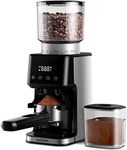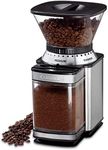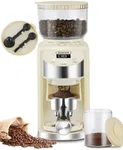Buying Guide for the Best Coffee Burr Grinders
Choosing the right coffee burr grinder can significantly enhance your coffee brewing experience. Burr grinders are preferred over blade grinders because they provide a more consistent grind size, which is crucial for making great coffee. When selecting a burr grinder, it's important to consider several key specifications to ensure you get the best fit for your needs. Understanding these specs will help you make an informed decision and enjoy the perfect cup of coffee every time.Grind Size SettingsGrind size settings refer to the range of coarseness or fineness that the grinder can produce. This is important because different brewing methods require different grind sizes. For example, espresso requires a very fine grind, while French press needs a coarse grind. Grinders with a wide range of settings offer more versatility. If you enjoy experimenting with various brewing methods, look for a grinder with multiple settings. If you stick to one method, a grinder with fewer settings may suffice.
Burr TypeBurr type refers to the shape and material of the burrs inside the grinder. There are two main types: flat burrs and conical burrs. Flat burrs tend to produce a more consistent grind and are often found in higher-end models, while conical burrs are quieter and can handle a wider range of grind sizes. The material of the burrs, usually steel or ceramic, also affects durability and heat retention. Steel burrs are more durable and common, while ceramic burrs stay cooler and are less prone to wear. Choose based on your preference for consistency, noise level, and durability.
Grind SpeedGrind speed refers to how quickly the grinder can process coffee beans. Faster grinders can save time, but they may generate more heat, which can affect the flavor of the coffee. Slower grinders tend to preserve the beans' flavor better but take more time. If you value speed and convenience, a faster grinder might be suitable. However, if you prioritize flavor and are willing to wait a bit longer, a slower grinder is the better choice.
CapacityCapacity refers to the amount of coffee beans the grinder can hold at one time. This is important if you regularly make large batches of coffee or if you prefer to grind beans in advance. Grinders with larger capacities are ideal for households with multiple coffee drinkers or for those who entertain guests often. If you usually make coffee for just yourself, a smaller capacity grinder will be sufficient and take up less counter space.
Build QualityBuild quality encompasses the materials and construction of the grinder. A well-built grinder will be more durable and provide consistent performance over time. Look for grinders made with high-quality materials like stainless steel or heavy-duty plastic. Pay attention to user reviews and brand reputation to gauge the reliability of the grinder. If you plan to use the grinder frequently, investing in a higher-quality model will ensure it lasts longer and performs better.
Ease of CleaningEase of cleaning refers to how simple it is to maintain the grinder. Coffee grinders can accumulate oils and residues that affect the taste of your coffee if not cleaned regularly. Grinders with removable parts or those designed for easy disassembly make cleaning more straightforward. If you prefer low-maintenance appliances, look for a grinder that is easy to clean and comes with clear cleaning instructions. This will help you keep your grinder in good condition and ensure your coffee always tastes fresh.




















